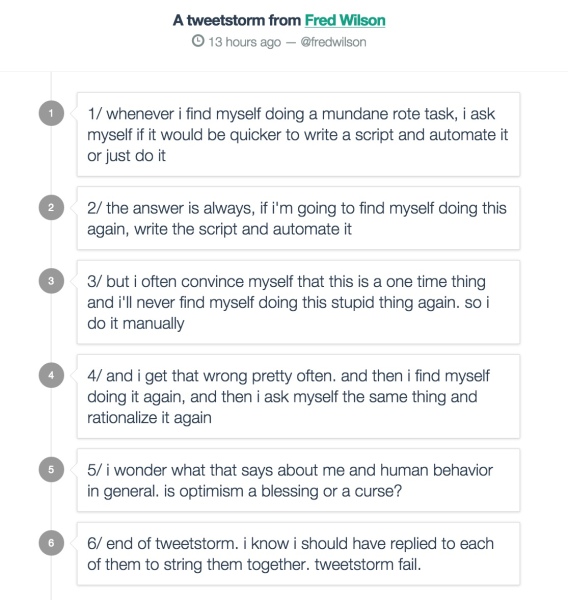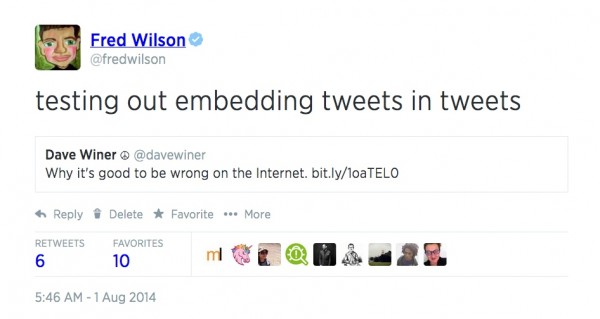I’ve been telling this fictional story about Dentist Office Software for years to describe why we are so focused on our “networks” investment strategy. Yesterday I told it at a HackNY event we did at the USV office and my partner Albert provided a finishing touch that really drives it home. Since I’ve never told the Dentist Office Software story here at AVC, I will do that and then I will add Albert’s alternate (and better) ending.
————-
An entrepreneur, tired of the long waits he is experiencing in his dentist’s office, decides that dentist offices are badly managed. So he designs and builds a comprehensive dentist office management system and brings it to market. The software is expensive, at $25,000 per year per dentist office, but it’s a hit anyway as dentists realize significant cost savings after deploying the system. The company, Dentasoft, grows quickly into a $100mm annual revenue business, goes public, and trades up to a billion dollar valuation.
Two young entrepreneurs graduate from college, and go to YC. They pitch PG on a low cost version of Dentasoft, which will be built on a modern software stock and include mobile apps for the dentist to remotely manage his office from the golf course. PG likes the idea and they are accepted into YC. Their company, Dent.io, gets their product in market quickly and prices it at $5,000 per year per office. Dentists like this new entrant and start switching over in droves. Dentasoft misses its quarter, citing competitive pressures, churn, and declining revenues. Dentasoft stock crashes. Meanwhile, Dent.io does a growth round from Sequoia and hires a CEO out of Workday.
Around this time, an open source community crops up to build an open source version of dental office software. This open source project is called DentOps. The project takes on real life as its leader, a former dentist turned socialist blogger and software developer named NitrousOxide, has a real agenda to disrupt the entire dental industry. A hosted version of DentOps called DentHub is launched and becomes very popular with forward thinking dentist offices that don’t want to be hostage to companies like Dentasoft and Dent.io anymore.
Dentasoft is forced to file for bankruptcy protection while they restructure their $100mm debt round they took a year after going public. Dent.io’s board fires its CEO and begs the founders to come back and take control of the struggling company. NitrousOxide is featured on the cover of Wired as the man who disrupted the dental industry.
—————
That’s the story. I hope to fine folks at YC, Sequoia, and Workday don’t mind me using their names in this fictional story. I picked the very best companies in the industry and my use of their brands is a compliment. I hope they take it that way.
This story is designed to illustrate the fact that software alone is a commodity. There is nothing stopping anyone from copying the feature set, making it better, cheaper, and faster. And they will do that. This is the reality that Brad and I stared at in 2003 as we were developing our initial investment thesis for USV. We saw the cloud coming but did not want to invest in commodity software delivered in the cloud. So we asked ourselves, “what will provide defensibility” and the answer we came to was networks of users, transactions, or data inside the software. We felt that if an entrepreneur could include something other than features and functions in their software, something that was not a commodity, then their software would be more defensible. That led us to social media, to Delicious, Tumblr, and Twitter. And marketplaces like Etsy, Lending Club, and Kickstarter. And enterprise oriented networks like Workmarket, C2FO, and SiftScience. We have not perfectly executed our investment strategy by any means. We’ve missed a lot of amazing networks. And we’ve invested in things that weren’t even close to networks. But all of that said, our thesis has delivered for us and we stick to it as much as we can.
So here’s Albert’s alternate ending (with my editorial license on the colorful aspects of this story):
—————
A young dentist, named Hoff Reidman, just starting up his own private practice, decides that he wants to network with other dentists. Because Hoff went to CMU before going to dental school, he’s pretty technical and he hacks together a site in Ruby called Dentistry.com. He emails all of his friends from dental school and they sign up. Every dentist wants to be on Dentistry.com and the site takes off. Hoff realizes he has to quit his dental practice to focus on Dentistry.com. Albert Wenger, who happens to be a patient of Hoff’s, convinces him to let USV do a small seed round of $1mm to help build a company around Dentistry.com. Hoff comes up with a product roadmap that allows patients to have profiles on Dentistry.com where they can keep their dental records, book appointments, and keep track of their dental health. It also includes mobile apps for patients to remind them to floss and brush at least twice a day. While Dentistry.com is free to use for anyone (dentist or patient), it monetizes with native advertising, transactions between dentists and their patients, and transactions between patients and providers of consumer dental health products, and transactions between dentists and providers of dental equipment and products. Dentistry.com ultimately grows into a $1bn revenue company and goes public trades at a market cap of $7.5bn. Wall Street analysts love the company citing its market power and defensible network effects.
————-
I hope you enjoyed this fictional story. I find it explains our network thesis simply and easily. I will keep telling it to groups I talk to, but now with Albert’s ending. I like it very much. Thanks Albert.



